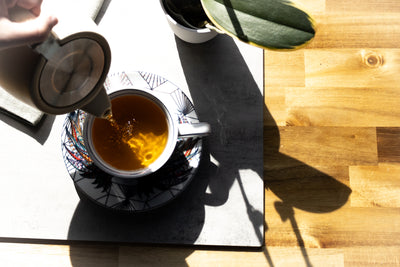The world is a big place and tea is enjoyed in every corner of it. Tea is, after all, the second most consumed beverage in the world. Each tea growing region imparts its own flavors and styles to its tea, join us as we touch on some of the specifics of each.
Table of Contents
China
China is the birthplace of tea and remains one of the largest tea producers globally. It has a rich tea culture and produces a wide variety of teas, including green tea, black tea, oolong tea, white tea, and pu-erh tea. Famous tea regions in China include Fujian, Zhejiang, Yunnan, and Anhui.
India
India is one of the largest tea producers in the world. It is renowned for its black teas, particularly Assam and Darjeeling. Assam teas are robust and malty, while Darjeeling teas are prized for their delicate and floral flavors. Other tea-growing regions in India include Nilgiri and Kangra.
Sri Lanka (formerly Ceylon)
Sri Lanka is known for its Ceylon tea, which is predominantly black tea. Ceylon teas are known for their bright and brisk flavors. The country has several tea-growing regions, including Nuwara Eliya, Uva, and Dimbula.
Japan
Japan is famous for its green teas, especially matcha, sencha, and gyokuro. Japanese teas are known for their vibrant green color, umami flavor, and meticulous production methods. Some well-known tea regions in Japan include Uji, Shizuoka, and Kagoshima.
Kenya
Kenya is a major player in the global tea industry and is renowned for its black teas. Quickly gaining popularity in the tea world is purple tea, also typically grown in Kenya. Kenyan teas are known for their bold and robust flavors. Tea production in Kenya is mainly centered around the highlands, including the regions of Kericho, Nandi, and Kisii.
Taiwan
Taiwan, also known as Formosa, is known for its high-quality oolong teas. Taiwanese oolongs are prized for their complex flavors and fragrances. Notable tea regions in Taiwan include Alishan, Dong Ding, and Li Shan.
These are just a few examples of the main tea-producing regions, but tea is grown and enjoyed in numerous other countries, including Nepal, Vietnam, Indonesia, Bangladesh, and many more. Each region has its own unique tea characteristics and contributes to the diverse world of tea.
There are a limited number of tea producers in North America, with one of the largest being Bigelow near Charleston, SC.
Popular Herbs and Tisanes
South Africa
Rooibos Tea
Rooibos Tea: Rooibos (pronounced roy-boss) is grown predominantly in the Cederberg region of the Western Cape province in South Africa. The unique climate and soil conditions of this area contribute to the cultivation of high-quality rooibos. Rooibos plants require specific conditions, including well-drained sandy soils and a Mediterranean climate with hot summers and cold winters. The Cederberg region's mountainous terrain is considered particularly suitable for growing rooibos.
Honeybush Tea
Honeybush Tea: Honeybush tea is grown in various regions of South Africa, including the Eastern Cape, Western Cape, and the Langkloof Valley. The Eastern Cape, in particular, is known for its honeybush cultivation. Similar to rooibos, honeybush plants thrive in well-drained, acidic soils and require a Mediterranean-type climate with mild winters and warm summers.
South America
Yerba Mate
Yerba Mate: Mate is a traditional drink dating back centuries. Primarily produced in Argentina, Brazil, Paraguay, and Uruguay, mate has enjoyed a resurgence in popularity over the last few years.
Argentina
Argentina is the largest producer and consumer of yerba mate. The provinces of Misiones, Corrientes, and Entre Rios are the primary growing regions within Argentina. Misiones, located in the northeastern part of the country, is particularly renowned for its high-quality yerba mate production.
Brazil
Yerba mate is also cultivated in southern Brazil, primarily in the states of Paraná, Santa Catarina, and Rio Grande do Sul. These regions share borders with Argentina, and the climate and soil conditions are favorable for yerba mate growth.
Paraguay
Paraguay has a long history of yerba mate consumption and production. The region of Alto Paraná, located in the eastern part of the country, is known for its yerba mate plantations.
Uruguay
Yerba mate is also grown in Uruguay, particularly in the northern part of the country near the border with Brazil and Argentina.
Ecuador
Ecuador is the main producer of guayusa and is renowned for its high-quality cultivation. The Kichwa indigenous people of the Ecuadorian Amazon have a long history of cultivating and consuming guayusa. They consider it a sacred plant and use it in traditional ceremonies and rituals.
Other herbs, teas, and regions
Numerous blends contain herbs that originate all over the world. Greek mountain tea hails from the Mediterranean region. Much of the world's chamomile grows in Egypt. North America is known for herbs such as peppermint and dandelion. Chaga mushroom comes from northern regions in the US and China/Russia.

